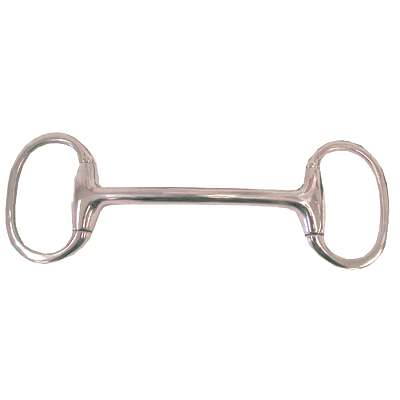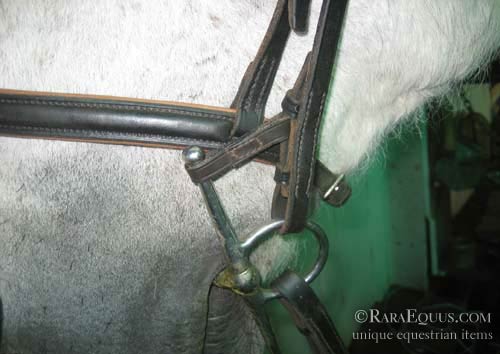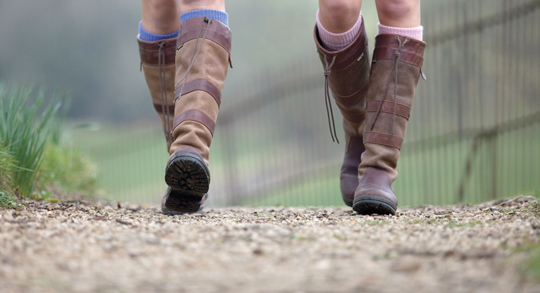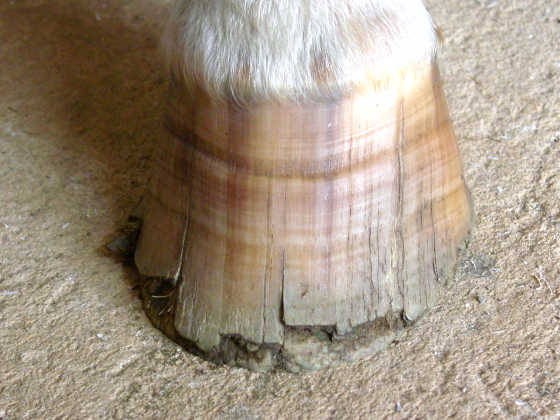Today I'll start covering the next part of the bit - the bars, or part that goes in the mouth. There are a billion options out there. Many people talk about certain reactions of their horse to certain actions - my best tip is to get a friend, grab your bit of choice, and let them pick up contact, pull, jerk, etc on you like you would on your horse. It's definitely educational!
Mullen mouth: straight across, no joints. Often found rubber covered, these bits influence by "tilting" in the horse's mouth. Foxie's pelham was like this, though there are also rubber "dog bone" or mullen mouth bits that are bendy - interesting, but make sure they don't sustain damage and keep in mind that sometimes the cores can snap!
There are several mullen options - the simple metal straight bar, the rubber "dog bone" and the happy mouth ridge are common, and as you see come on a variety of cheeks:


Some rubber models are flexible - usually the black rubber being the least flexible and the white plastic/stuff being the most flexible. The most flexible mouth piece material is the Nathe or Herm Sprenger Duo. I personally bought a Nathe, as my young horse was broken out in one, and really loved while it worked for the young horse. Eventually, her needs changed and we moved on, but these bits are pretty cool!
The Nathe snaffle - look at that flexibility!
And the Duo:
Single Joint: The standard horse bit, with a center joint. Some people feel that these can create a "nut cracker" sensation on the horse's pallet and tongue, but they have been an industry standard for a long time.
French Link: The french link is the new black of horse bits. Gentle, this bit is considered "soft" as it breaks more gently over the tongue and doesn't have the nut-cracker action of the above single link snaffle. I like the french link for it's ability to pick up one side of the horse's mouth, or their dropping shoulder and have more finesse for dressage.
Dr. Bristol: Don't be fooled. I know this looks like a french link. Believe me, it's not. The center link is rotated so the edge - not the nice flat center - lays on the tongue. A little sharper reprimand than our friendly Mr. French Link. The best way to tell the difference is that the french link has the curve to the center link - the Dr. Bristol does not. This is NOT dressage legal.
The "bean": The bean, also called a "lozenge" is another version of a french link, though not as tricksy as the Dr. Bristol. The bean can also be substituted for rotating links, rubber link on a metal bit, etc etc. The "link" is rounded or ball shaped. Always double check your rule book for dressage when using one of these, as you can see that they do come in alternate materials which may or may not be legal. Happy mouths often come with a "lozenge" or center link that rotates, which I believe is not legal, as well, so watch out for that.
There are some cool Herm Sprenger models out there that are an interesting twist on our "bean" or Lozenge options:
Waterford: The Waterford is definitely not crystal. And it's definitely not dressage legal.
This interesting little piece just may be an OTTB owner's best friend. The Waterford is great for horses who grab the bit (like racehorses who have been taught to grab the bit and lean on it for racing balance) and abscond with you across field and glen. The Waterford is soft and liquidy, so there is nothing to lean on - just don't "see-saw" your reins or loose your temper and tug. In the right hands, the Waterford can be a great alternative to some of the bigger bits out there, like Pelhams, running gags and other "fun". They come in a multitude of mouthpieces including gags, bouchers, loose rings (as pictured), dees and full cheeks so they do offer a lot of options.
The slow twist: The slow twist is another "in between" bit that might be that little change you need to keep your snaffle-mouthed jumper in a snaffle. The slow twist gives the bit a little extra "hey there" with your half-halts, and can often be the thing you need to get your horse back to make the striding in that combination.
The double twisted wire: This is not a bit for the faint of heart, or the soft of mouth. I have used this bit on one horse, at a camp, and lawd knows he needed it; and even with it I had no brakes, no steering and no flexibility of jaw or neck. My advice? Just don't use it.
Mullen mouth: straight across, no joints. Often found rubber covered, these bits influence by "tilting" in the horse's mouth. Foxie's pelham was like this, though there are also rubber "dog bone" or mullen mouth bits that are bendy - interesting, but make sure they don't sustain damage and keep in mind that sometimes the cores can snap!
There are several mullen options - the simple metal straight bar, the rubber "dog bone" and the happy mouth ridge are common, and as you see come on a variety of cheeks:


Some rubber models are flexible - usually the black rubber being the least flexible and the white plastic/stuff being the most flexible. The most flexible mouth piece material is the Nathe or Herm Sprenger Duo. I personally bought a Nathe, as my young horse was broken out in one, and really loved while it worked for the young horse. Eventually, her needs changed and we moved on, but these bits are pretty cool!
The Nathe snaffle - look at that flexibility!
And the Duo:
Single Joint: The standard horse bit, with a center joint. Some people feel that these can create a "nut cracker" sensation on the horse's pallet and tongue, but they have been an industry standard for a long time.
French Link: The french link is the new black of horse bits. Gentle, this bit is considered "soft" as it breaks more gently over the tongue and doesn't have the nut-cracker action of the above single link snaffle. I like the french link for it's ability to pick up one side of the horse's mouth, or their dropping shoulder and have more finesse for dressage.
Dr. Bristol: Don't be fooled. I know this looks like a french link. Believe me, it's not. The center link is rotated so the edge - not the nice flat center - lays on the tongue. A little sharper reprimand than our friendly Mr. French Link. The best way to tell the difference is that the french link has the curve to the center link - the Dr. Bristol does not. This is NOT dressage legal.
The "bean": The bean, also called a "lozenge" is another version of a french link, though not as tricksy as the Dr. Bristol. The bean can also be substituted for rotating links, rubber link on a metal bit, etc etc. The "link" is rounded or ball shaped. Always double check your rule book for dressage when using one of these, as you can see that they do come in alternate materials which may or may not be legal. Happy mouths often come with a "lozenge" or center link that rotates, which I believe is not legal, as well, so watch out for that.
Waterford: The Waterford is definitely not crystal. And it's definitely not dressage legal.
This interesting little piece just may be an OTTB owner's best friend. The Waterford is great for horses who grab the bit (like racehorses who have been taught to grab the bit and lean on it for racing balance) and abscond with you across field and glen. The Waterford is soft and liquidy, so there is nothing to lean on - just don't "see-saw" your reins or loose your temper and tug. In the right hands, the Waterford can be a great alternative to some of the bigger bits out there, like Pelhams, running gags and other "fun". They come in a multitude of mouthpieces including gags, bouchers, loose rings (as pictured), dees and full cheeks so they do offer a lot of options.
The slow twist: The slow twist is another "in between" bit that might be that little change you need to keep your snaffle-mouthed jumper in a snaffle. The slow twist gives the bit a little extra "hey there" with your half-halts, and can often be the thing you need to get your horse back to make the striding in that combination.
The double twisted wire: This is not a bit for the faint of heart, or the soft of mouth. I have used this bit on one horse, at a camp, and lawd knows he needed it; and even with it I had no brakes, no steering and no flexibility of jaw or neck. My advice? Just don't use it.
Yikes.
Other factors are also involved with bits, such as the weight. Sometimes you will see bits that are "hollow weight" or "weighted", and while it can be confusing, I say trust your gut! Light bits will be light in the horse's mouth, and thus the pressure you apply will be more noticeable - but light weights are usually large and round (as are happy mouth/rubber bits) which can be comfortable for your horse, as a larger diameter means more area for the pressure to be applied to.
Weighted bits are rather the opposite - They are a constant weight in the horse's mouth, and thus are "slower" where lighter bits are "fast" reacting. This means that the time between the sensation of your hand asking for something comes to full power more slowly, allowing you to be smoother and subtler. Foxie really likes hers - it's thinner than her french link eggbutt, and she seems to be perfectly fine with the single link bit. It's a loose ring, meaning less to lean on, and she seems more hesitant to grab this bit and go "dead" to my contact while ignoring me/running off/resisting.
Food for thought, huh?
Questions?
Ashley and Foxie














































